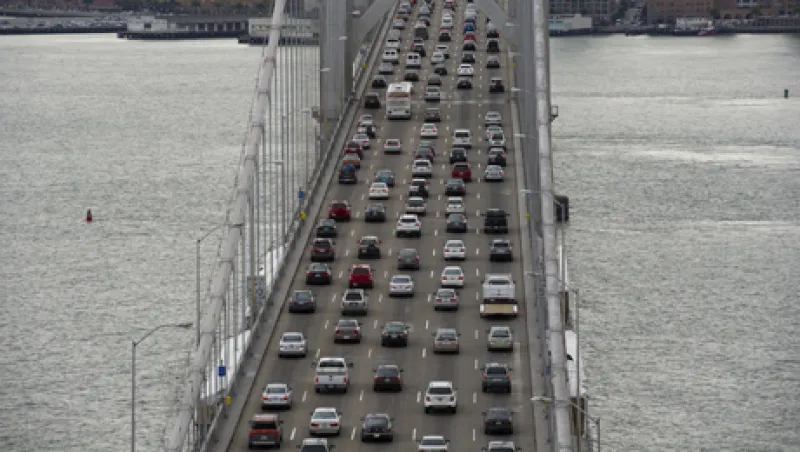Institutional investment in U.S. infrastructure is modest but on the rise. Long may the growth continue, for the gap between the country’s investment needs and the capacity of its strapped government budgets is daunting.
In a January report, the American Society of Civil Engineers estimated that the country’s infrastructure needs will exceed projected spending by $1.09 billion between now and 2020, based on current trends. Unless that shortfall is filled, the country could suffer a cumulative loss of economic output of $3.1 trillion over that period, the society claimed.
For anyone who has ever tried to get into Manhattan from New York’s John F. Kennedy International Airport or spent any time cruising on the country’s interstate highways, the U.S. infrastructure deficit comes as no surprise. But the financing gap spells at least as much opportunity as danger.
“Deteriorating infrastructure has a cascading impact on our nation’s economy, yet we have a real opportunity to make crucial investments in America’s infrastructure that will pay off in huge economic dividends,” said Gregory DiLoreto, president of the civil engineers society, in a press release accompanying the January report. Those dividends are attracting more and more institutions, especially long-term investors.
“Infrastructure assets are the best assets we have in the nation,” says Sonia Axter, managing director of infrastructure investments at the Union Labor Life Insurance Co., a union-owned insurer based in New York, which manages nearly $5 billion in assets. “They are important assets suffering from a lack of investment and adequate maintenance. There’s a great opportunity for institutional investors.”
Infrastructure assets play an essential role in local communities, and payments by users — whether government or private — tend to be linked to inflation, Axter notes. This latter feature makes them particularly attractive to pension funds, whose liabilities are often linked to inflation. In addition, revenues generated by infrastructure are relatively immune to the ups and downs of the economic cycle, providing a stable cash flow for investors, she adds.
Responding to these attractions, Ullico announced its first infrastructure move in December: a $20 million investment in a 30-year concession to upgrade and operate the water and wastewater facilities of Rialto, California. Ullico plans to expand its infrastructure program, which invests third-party money rather than Ullico’s own insurance revenue.
Thirty years is a common length for infrastructure deals made between investors and government, though some are longer still. This longevity is driving the continuing increase in infrastructure investment at John Hancock, says Robert Keough, managing director of alternative assets at the Boston-based life insurance company.
“We write some liabilities, such as long-term care insurance, that last as long as 70 years,” he says. “There’s a limited pool of credit out there, which we’d be interested in buying to back those long liabilities, so we seek other asset classes.” Infrastructure assets currently make up a “high-single-figure” percentage of Hancock’s investment portfolio, Keough adds, and the share is growing as the company writes more long-term liabilities.
A bread-and-butter infrastructure investment for John Hancock would be “power generation with a long-term contract to sell power to an investment-grade utility,” says Jerry Hanrahan, head of power and infrastructure at the company’s Bond and Corporate Finance Group. Rates of return for lower-risk infrastructure investments such as these are not spectacular, but they are eminently predictable — between 10 and 15 percent. A prospective rate of return above 15 percent is “generally too far above our risk profile,” says Hanrahan. Examples of such riskier projects might include an electricity generator without a long-term contract to supply a customer, or a greenfield toll road, he says. Such a toll road lacks a predecessor with a traffic history, which can be used to reliably estimate future revenues.
Diloshini Seneviratne, head of a three-person infrastructure team built up since 2010 at the California State Teachers’ Retirement System in West Sacramento, California, says the fund generally prefers deals where payment is based on the availability of infrastructure rather than the volume coursing through it. For that reason, she explains, “toll roads tend to be a little bit too risky for us.” The CalSTRS board has earmarked (though not yet fully invested) $3.5 billion, or 2.5 percent of its portfolio, for infrastructure investment. It has started to invest the money in third-party infrastructure funds but leaves open the possibility of making direct investments in the future. The desire for safe investments makes CalSTRS, like John Hancock, particularly keen on power-generation and transmission projects with long-term contracts.
Institutional investors’ preference for electricity infrastructure suggests plenty of interest in helping close the funding gap for power, which the civil engineer’s society estimated at $107 billion through 2020. Most of the remaining funding gap, a whopping $846 billion, represents a shortfall for surface transportation.
If this funding gap is going to be met, or even narrowed significantly, federal and local governments will have to increase the predictability of the investment framework. Institutional investors give mixed reviews to the Obama administration’s attempts to boost private infrastructure investment. “In transport we definitely need a more stable regulatory environment so that we know we can get a clearer view of the revenue stream,” says Seneviratne of CalSTRS. For example, the administration’s proposal for a national infrastructure bank, which would provide seed money to attract private investors, “could improve the environment for infrastructure investment,” she says. The idea remains stalled in Congress, however.
Locally as well as federally, political wrangling remains one of the great obstacles to U.S. infrastructure investment. Axter recalls how it took three years from the conception of the Rialto deal to its actual closing; the city council initially rejected the deal before eventually giving its approval. That kind of uncertainty is anathema to investors. As Axter puts it, “most investment managers are not set up to bear long-term development costs without knowing what will happen at the end.”






